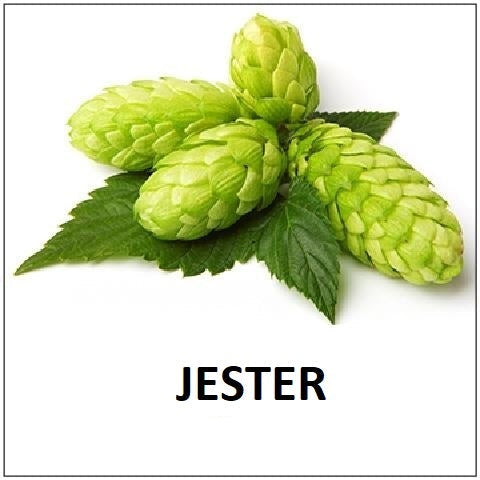Suggested videos
- Sku: 15225-100GM
- Barcode:
HOPS JESTER PELLETS
Jester Hop Pallets.
Jester is one of the first English hops developed that has some new world flavor. Traditional English hop varieties are earthy, floral, grassy, woody, herbal, and tea-like; with very little of the bold fruity flavors of citrus, berry, and tropical fruit many of the New World varieties are known for. Jester bridges these two flavor worlds.
Jester was born out of a breeding program meant to combine the best of both the New and the Old World. Charles Faram & Co. has been in the hop business since 1865. Initially, their Hop Development Program focused on trying to develop hedgerow varieties that were less susceptible to disease and had higher yields, but as the punchy “new world” hop character started to gain popularity across the world, the Hop Development Program sought a new goal: develop hybrid hops by crossing British and New World varieties.
To accomplish this, American varieties were brought in and crossed with traditional British rootstock. A cross between a female Cascade and an undisclosed British variety resulted in the seedling that would become Jester. From here, Jester went into planting trials. These trials showed Jester performing well above expectations with good yields and strong resistance to many diseases.
In 2013 Jester was released into the commercial brewing market. Jester remains a relatively small player in brewing realms, but this seems to be changing slowly as more people discover just what Jester can bring to the table: a traditional British appeal with a bit of New World freshness.
General Characteristics:
- Origin— UK
- Year Released— 2013
-
- Cones — tight cones; Jester also has smaller leaves which translates to more cones
- Susceptible to — Powdery Mildew
- Resistant to — Wilt, Tolerant to Downy Mildew
- Ease of Harvest — Easy
- Storage — Good
Acid Composition Breakdown
Note: Hop oil composition will vary between harvest years and where the hop was grown. The numbers below are meant to be an average only.
Alpha Acid: 7 – 9%
Beta Acid: 4 – 6%
Co-Humulone: 23 – 28%
Oil Composition Breakdown
Total Oils: 0.6 – 1.2 ml/100g
Myrcene Oil (% of total): 45 – 50%
Humulene Oil (% of total: 1 – 2%
Caryophyllene Oil (% of total): 0%
Farnesene Oil (% of total): <1%
Aroma & Sensory Description:
Jester is described as having new world-esque characteristics, but don’t expect the in-your-face sort of fruitiness many of the new American varieties have. Instead, Jester has some of those fruity notes but in a more delicate format. The three most commonly used descriptors for Jester are lychee, grapefruit, and blackcurrant. I’ve also seen it noted as having possible whispers of peach/mango/berry and pepper. Expect some earthy, musty, herbal elements to make an appearance, complements of the British side of its parentage and terroir.
Overall it is considered mellow in both its flavor/aroma and bittering.
Use:
Jester is considered a dual purpose hop, though most brewers seem to relegate its work to aroma and flavor. If bittering with Jester, expect a mild herbal bitterness. Using Jester as a late addition, and especially in dry-hopping, will bring out more of Jester’s fruity side.
It can complement other hop varieties very well and likely could be used to bridge more intense varieties used in the same beer.
Common Beer Styles Using Jester Hops:
- English Bitters
- Pale Ales
- IPAs
- Saisons
- Stouts
- Porters
- Blondes
- British Brown Ale
- Dark Mild

HOPS JESTER PELLETS


